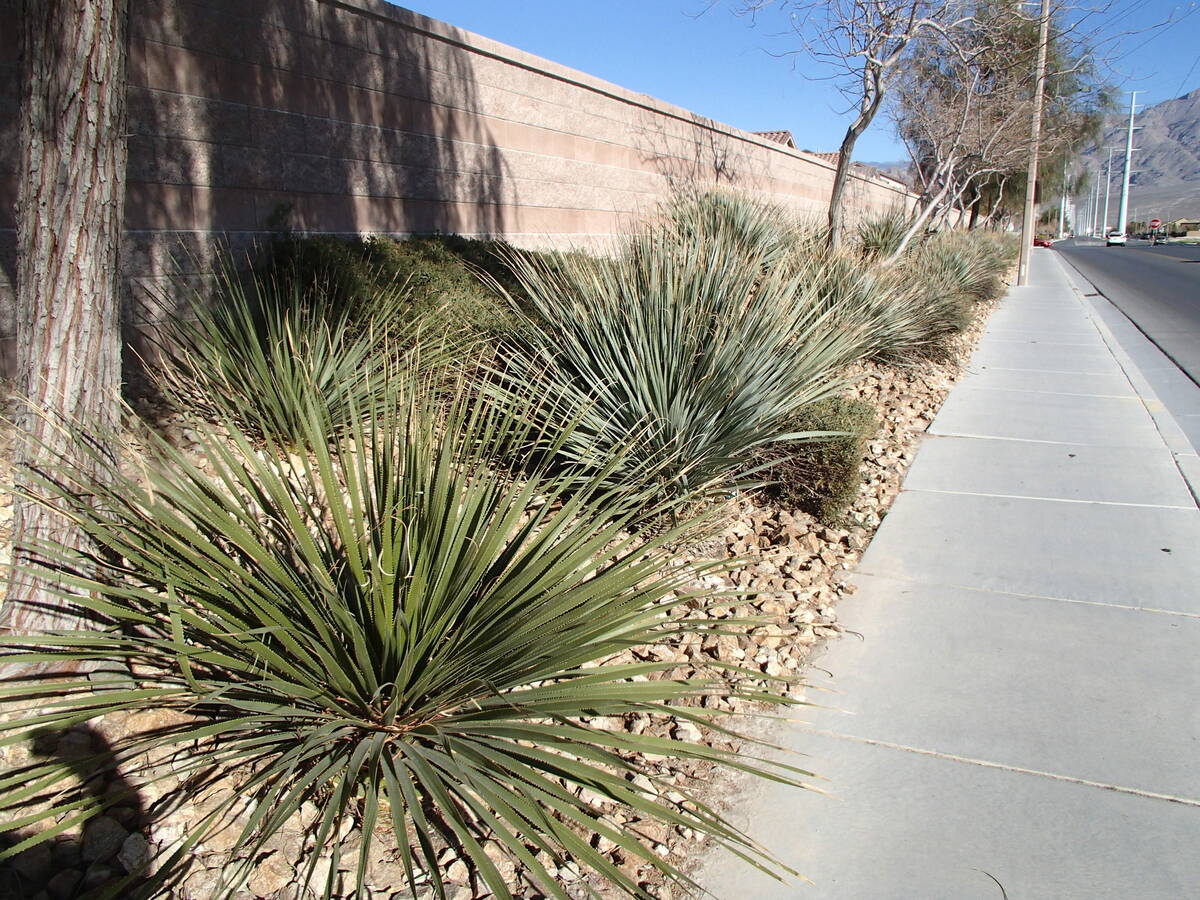Daytime temperatures too hot to plant desert spoon
Q: I purchased six 5-gallon-sized desert spoons, but I haven’t planted them since it’s been so hot. Should I plant them in the early morning when it’s about 90 degrees F? I have watered them three times a week.
A: It’s not the best time of year to plant them, but yes, if you are going to plant them, plant them at a time during the day when it’s cooler and plant in wet soil. I think the major problem is the sunlight and not temperature.
Never plant in a dry hole. In other words, make sure the hole has been filled with water the day before or at least the soil is wet when it’s planted. If you elect to plant during the heat, plant as quickly as possible so the roots don’t dry out. Planting in a dry hole during the heat of the day is a common mistake made by contractors.
The hole for planting should be dug three times the diameter of a 5-gallon container, even if it’s a xeric or desert plant. It’s not important to dig the hole deep unless it’s necessary. Every time you water, the water should wet all the roots to a depth of 12 to 18 inches.
Q: Can argan trees thrive in Las Vegas climate? I live in Summerlin and am thinking about planting a few because they provide a nice shade canopy. Would rats be attracted to eat the fruit? I don’t want to encourage a rat population.
A: You have the right idea. The argon tree comes from the fringes of the Sahara Desert so potentially it could be used for lower amounts of applied water to a landscape. It has been reported to take the heat of the desert because of its deep roots. This is what tree gurus call a phreatophyte. Its water use is probably similar to other desert phreatophytic trees such as mesquites and palo verde, native to the Mojave and Sonoran deserts, respectively.
Argon oil is popular right now. It’s pressed from the seeds of its fruit.
This tree might be hard to find in the size you want. The tree is native to parts of Morocco in the seasonally dry parts of sub-Saharan Africa. There has been some interest in propagating this tree for use in Africa.
Research needs to be done before it’s available to the public elsewhere as trees. For instance, nothing is available on the best method of propagation to be used, the soil (microbiology), or selections preferred for landscapes.
Make sure that trees with a similar water use are on the same irrigation line. Water lines turn the water on and shut it off, all at the same time. The depth that water penetrates is dictated by the number of irrigation emitters used.
As far as attraction to rats, I would have to guess. Rats are omnivorous, which means they will eat plants or animals. Like other animals, they have food preferences and choices.
My guess is that argon fruit might be low on their list of preferences. But if nothing is around for them to feed on, it should attract them.
Q: When is a good time to trim sago palms planted in the ground? I want to change mine from shrubs to little trees with trunks.
A: I recommend pruning sago palm (cycad) any time the hand pruners are sharp. This means any time of the year as long as pruning cuts are made with a hand pruner.
The trunk will not be damaged with close pruning cuts. Start at the bottom of the plant and remove the lowest (anything damaged or yellow) first.
Hide cuts made. Bottom fronds are the oldest and usually the most sickly or damaged. Growth comes from the center of this plant. The center of the plant is the part you need to leave alone.
Always carry hand pruners with you when gardening. You never know when you need them.
Making cuts with loppers (large pruners or saw) should only be done when it’s cooler — during the winter months of late fall or early spring. Larger pruners will make one empty hole for sun damage during the heat of the summer months.
Make large pruning cuts when the tree has time to cover the damage. Make sure any pruners used are clean and sharp before beginning.
Q: A community garden has a mesquite tree 16 feet wide and two palo verde 20 to 25 feet wide. I have been hand-watering these trees into a basin of sandy loam soil.
We are now changing to drip emitters and a battery-operated irrigation timer. At about 8 inches down, the soil is very hard so I’ve placed 18 to 20 2-gph emitters about 4 feet apart around these trees.
I’ve been hand watering three days a week for two hours at a time. But I can’t push a soil probe any deeper than that 8 inches on any emitter except emitters close to the trunk where the soil is softer. The trees look OK. Should I be doing something differently?
A: The information you gathered is very helpful. There are two ways of irrigating plants in a soil: quickly flooding a basin under the canopy of the tree (bubblers under high pressure) or using slower applications of water through drip irrigation (lower pressure).
With drip irrigation, water enters the soil slowly and immediately spreads depending upon soil texture. With sandy loam soil, I believe the distance of drip emitters should be about 18 to 24 inches apart to get an even distribution of water, not four feet.
Your spacing of drip emitters at 4 feet and 2 gallons per hour means that more water should be applied to these 4-foot areas. If you are watering for 30 minutes, increase that time to two hours or add more emitters and put them closer together. If in doubt, increase the amount of water applied until it’s at the proper depth.
Tree roots follow water. In the desert where water is applied, roots flourish. Soil is also important for plant stability.
The larger the plant (such as trees), water must be applied to a wider area or these trees will fall over. Trees 40 to 60 feet tall need water applied to a wider area than trees 15 to 20 feet tall for stability.
The University of Arizona thinks the soil under the entire canopy of the tree should become wet after irrigation. I believe that’s impractical for most homeowners.
Instead, I encourage people to wet at least half the area under the canopy of each plant. When in doubt, use a 6-foot diameter basin. This allows the basins to catch enough water for small to moderately sized trees. Enough water should be applied to wet the soil 18 inches deep.
Make sure any drip irrigation system can be flushed. That means flushing the lines periodically and cleaning the drip filter at the same time. It’s less important to flush frequently with city water but still important. Dirty water in, more frequent flushing is needed.
Q: Like many others, I am sure, I have several established shrubs and trees that have suffered this long hot period. These have been in the ground for 15 to 20+ years, and I have never experienced this. The shrubs along the back wall face due west, thus they get all the late sun. I wonder if they will drop these burned leaves eventually and develop new growth.
A: Check to make sure this is not due to water or soil improvement. In previous years, you might be able to get by without either. This plant does not do well in direct desert light or heat.
I believe this is Rhaphiolepis judging from the leaves I could see. This shrub needs quite a bit of water, what we call “mesic” in its water use.
Being from India and China, where soils are not a desert type, it could use some soil improvement if it’s not been done before. This shrub does not do well in south- or west-facing hot exposures but does better on the east or north sides of homes with some shade in the afternoon.
Otherwise, it does well in full sun but having the added heat — and growing alone — can cause some serious damage to it.
If the leaves are damaged enough they die, the leaves will drop and new leaves will be grown to replenish the dropped leaves. Otherwise, damaged leaves are frequently retained by plants.
Compost can be applied to the dry soil areas near the plant and watered in. Extra water may be helpful. See if that causes it to get greener in the fall.
Otherwise, if it’s done well in the past this shrub may have to be cut back in the fall and regrown or replaced with something about the same size and xeric in its water use.
Bob Morris is a horticulture expert and professor emeritus of the University of Nevada, Las Vegas. Visit his blog at xtremehorticulture.blogspot.com. Send questions to Extremehort@aol.com.























